By Zach Loeks
This is the second of a two-part article introducing the author’s ideas for using permaculture techniques to improve the profitability and resiliency of market gardens. For part one, click here or see the October 2017 GFM. For more information, see his book, The Permaculture Market Garden, now available from GFM.
The permabed system
The term Permabed is short for permanent, agro-ecological bed. Converting your market garden fields to permanent raised beds will facilitate integrating perennial and annual production. Permabeds consist of garden beds formed by moving path material to the bed top instead of plowing, and the beds never lose their place in space- creating a permanent framework for production. How to make the beds and reform them, as well as the permanence of their placement, results in important criteria for movement towards an agro-ecosystem.
Soil life conservation
Permabeds maintain a soil life conservation core at the heart of every bed. Path material is reformed onto the bed top and this new soil receives shallow tillage and leaves the core of the bed undisturbed for soil microorganism colonies to grow and prosper.
Environmental mapping
Because the beds hold their place in space they create a field organization of environmental data points. Each bed can be mapped for its specific environmental character (soil, drainage, geology, microclimate). This is beneficial for annual crop rotations— beds that dry out sooner are put into early crops or those with a high water table are used for late-planted water-lovers.
More importantly for the permaculture market garden is the intimate knowledge of a bed’s environmental character for the selection of site-suitable perennial species. Perennials live a long time and must be planted in the best site and there are perennial solutions for all sites— often maximizing a poorly managed part of a field that was too dry, wet, acidic, stony or rocky. Once the garden is converted to raised beds and mapped for environmental character then suitable perennials can be planted— for instance, elderberries in wet areas and pears in dry stonier ground. But first market gardens must decide on an organized land pattern for integration.
Organized land patterning
Repetition lends itself to patterning. Similar to alternating a pattern when knitting (knit, pearl, knit, pearl) or integrating the weft and warp when weaving, we can pattern the canvas of garden beds to integrate annuals and perennials. A repetition of Permabeds can be patterned for any specific ratio of perennials and annuals to achieve the mimicry of a desired agro-ecosystem’s form and function. Patterned land is managed on three scales.
The single Permabed is the primary unit for garden operations (seeding, bed reforming, etc) and the focal unit for soil health through maintenance of the soil conservation zone by reforming the beds instead of plowing.
The triad is the basic unit for crop guild design (annual and perennial) with a focus on designing for crop mutualism in time/space/energy and overall management efficiency (such as leaving access beds). Triads are designed based on a center bed and two outer beds and guilds organized around a chosen key species— perhaps Asian pears in a center bed and black raspberries in the two outer beds.
A Permaplot is one perennial (PERA) triad followed by three annual (ANA) triads. Permaplots can either start with a hand-harvest perennial triad (namely larger tree species in a center bed) or a machine-harvest perennial triad (such a berries) in outer beds. Alternating these different perennial triads across a field in a 1:3 ratio with annual crops is the correct organized pattern for a woodland agro-ecosystem to develop.
Market gardens are transition-ready
Market gardens are well suited to transition to an agro-ecosystem because:
We think in terms of beds, instead of rows. Though it should be noted that many market garden beds are simply compacted paths and fluffed bed tops that quickly settle by year-end and they should be replaced by Permabeds.
We use tools and equipment designed for the bed scale whether hand-held or tractor-powered.
Our crop rotations work well when intensively managed on the bed, triad scale and permaplot scale.
We are well acquainted to the management, production and marketing of diverse crops— adding new niche perennial products to the CSA or market stall is quite feasible.
Our garden crops will greatly benefit from the goods and services resulting from agro-ecological production— namely soil regeneration, microclimate regulation and improved pest management.
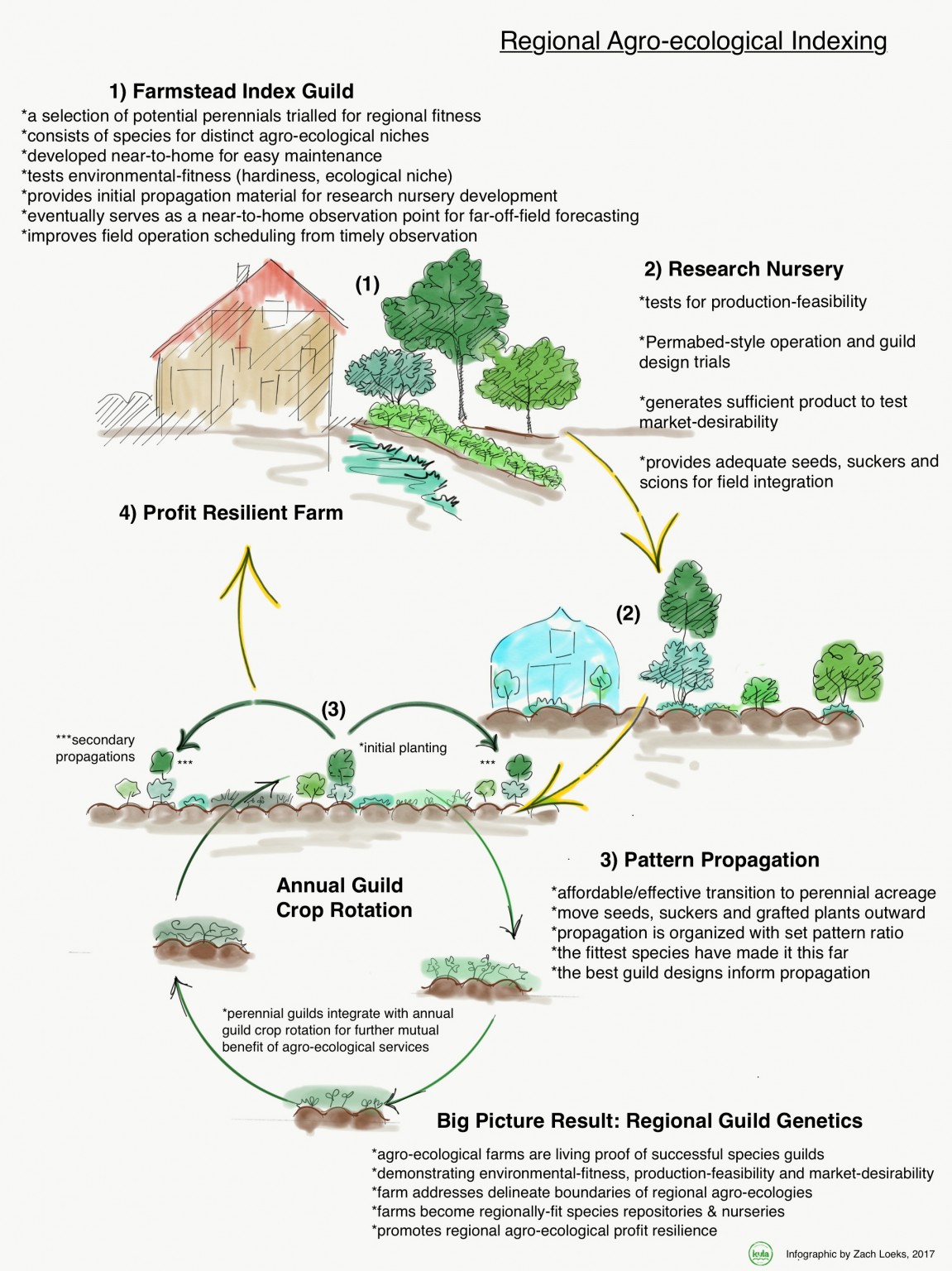
Index guilds, nurseries & propagation
Now is the time to begin selecting the best perennial species for your agro-ecosystem, design perennial guilds and integrate them into the market garden landscape in an affordable and efficient manner. The following system provides a means to trial perennial species for regional fitness: environmental fitness, market desirability and production feasibility, and to affordably generate the propagation material necessary for a woodland agro-ecosystem.
Agro-ecosystem transition process
1) Establishment of an index guild: an edible landscape around the home or farmstead to begin initial trialing of potential new perennial cultivars and eventually serve as a near-to-home window into far-off-field forecasting. Index guilds are used to trial species hardiness and companionship potential with other species under trial.
Development of a research nursery on the field edge to further trial the best cultivars from the Index Guild and to generate adequate propagation material for future field plantings and enough product to test the market demand for the new crops.
Continued pattern propagation of the best (most fit) varieties into initial perennial triads in the larger market garden field and then repletion of successful perennial guilds across a field as secondary and tertiary propagation.
Perennial guild regional fitness criteria
Environmental fitness- perennial species must be hardy to the actual hardiness zone of your property’s microclimates, not just nametag hardiness. Relying strictly on nametag hardiness for your official hardiness zone can pose problems- a perennial species may be less cold hardy then claimed on the tag. In contrast, varieties can sometimes be much hardier— there is a marketing opportunity in growing a great variety outside of it’s normal range!
Perennials must also be trialed for their ecological niche in association with other companion species. How well does species X grow in the shade of species Y? Will species Q harm species Z? Is there a specific synergy between a dwarf pear and a grape?
Market desirability- species should be chosen for known markets and these markets tested for their actual demand of new niche products: specialty fruit, berries, herbs, wood products, rare honey flavors, etc. By first testing species in an index guild and then further testing and propagating them in a nursery bed, the farm will begin to have decent yields of the edible products before major field production starts— this allows testing the markets for their demand of unique products. Gauging the demand will provide valuable feedback into the relative ratio of different species in the emerging agro-ecology.
Production feasibility- species must be assessed for their suitability to be grown using specific operational standards for short and long-term success. This includes the management such as weeding, irrigation, harvest, etc. It is especially important to consider harvest and future propagation of your own genetic material as key design criteria for perennial guilds. Design for access to perennial species by intercropping beds of dominant woody tree species with beds of low growing herbs, berries or asparagus— all of which can be driven over by truck, tractor or cart at the time of year when the fruit trees will yield heavily and require efficient means of transporting the crops out of the field. Design for future propagation includes understanding how species are propagated (seeds, suckers, scions, etc.) and designing the perennial guild for efficient harvest of genetic material for nursery stock.
Integration affordability- perennials should be integrated into the garden in an affordable manner that minimizes expense and maximizes short-term and long-term goods and services. A big part of this is the clear trajectory of trialing perennials (see infographic) in an edible landscape around the farmstead in the form of a farmstead index guild, the movement of the most environmentally fit species into a research nursery to test production feasibility and market desirability and then the affordable pattern propagation of those species that are most regionally fit into the field.
This process of trialing and propagating is simple. Three individuals of chosen cultivars (say Northbrite Pear, Tundra haskap, Somerset grape, etc.) are planted in a farmstead index guild and serve to produce enough propagation material (seed, scion, sucker, etc.) to plant a nursery bed, which provides enough material to plant a full size bed (100-300 ft long) which then can be used every year to triple the space in given species— if desired— or to produce transplants for nursery sale. During this process regional agro-ecological fitness is indexed (a living assessment and record) for key criteria environmental fitness (data from stage 1), market desirability (data from stages 1, 2), and production feasibility (data from stages 1, 2, 3).
The key to a successful transition to agro-ecological production is a smooth and routine process of gradually trialing and integrating perennial species into the market garden. This transition model ensures new perennial crops are not grown in a substantial way until they have proven that they meet all criteria for regional fitness, at which point the farm will have generated its own data to integrate new guilds with proper design and affordably-acquired plants from its own nursery for ecosystem establishment.
Agro-ecosystems, namely the woodland market garden, offer many goods and services to improve market garden profit resilience. Since market gardens are already transition-ready they need only begin by building Permabeds, conceptualizing an organized land pattern and then following the agro-ecosystem transition process of trialing, designing and propagating perennial guilds for integration into their new permaculture market garden.
Zach Loeks is a market gardener, farm consultant and educator farming in the Ottawa Valley of Ontario, Canada.
For more information, see the author’s book, The Permaculture Market Garden, available from GFM.
.png)

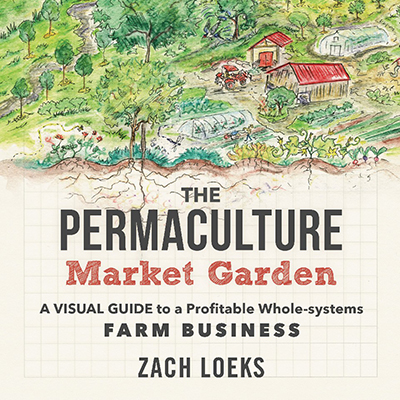
 This is the first of a two-part article about using permaculture techniques to improve the profitability and resiliency of market gardens.
This is the first of a two-part article about using permaculture techniques to improve the profitability and resiliency of market gardens. 
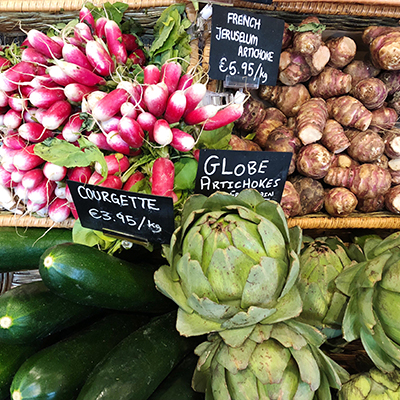

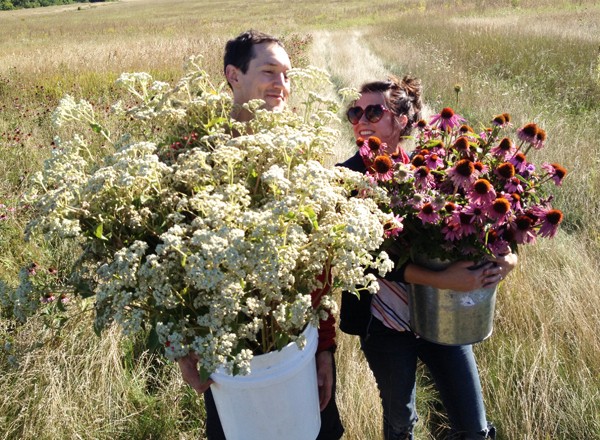
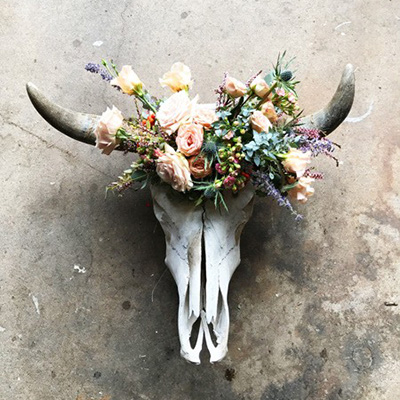
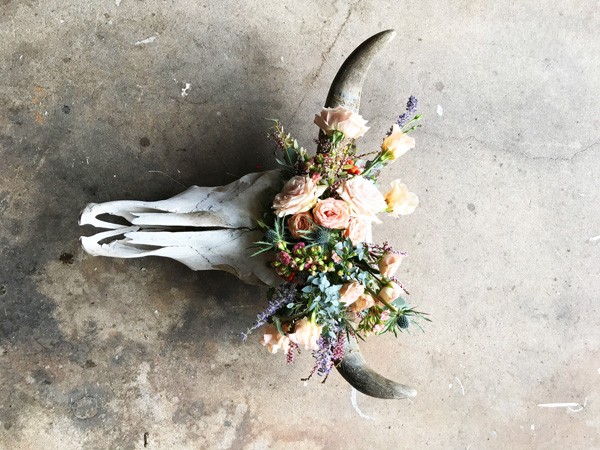 Floral designers get creative when it comes to vases and vessels. For Emily Calhoun at Floriography in New Mexico that means sometimes arranging flowers and desert plants in desiccated horned cow skulls. The floral cow skull is a signature of Floriography weddings.
Floral designers get creative when it comes to vases and vessels. For Emily Calhoun at Floriography in New Mexico that means sometimes arranging flowers and desert plants in desiccated horned cow skulls. The floral cow skull is a signature of Floriography weddings. 
 Sisters grow native perennials in Florida and New York
Sisters grow native perennials in Florida and New York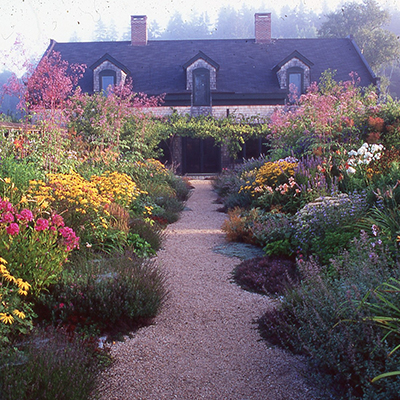
 Since its founding in 1968 by my husband Eliot Coleman, Four Season Farm has sought to produce the best vegetables possible, using soil-based organic methods, on a small amount of land. When I showed up in 1991, Eliot had begun to pioneer winter vegetable production, and I was delighted to give up the landscape design business I’d run in Connecticut and grow veggies with him. Then, about 10 years ago, flowers started to creep in.
Since its founding in 1968 by my husband Eliot Coleman, Four Season Farm has sought to produce the best vegetables possible, using soil-based organic methods, on a small amount of land. When I showed up in 1991, Eliot had begun to pioneer winter vegetable production, and I was delighted to give up the landscape design business I’d run in Connecticut and grow veggies with him. Then, about 10 years ago, flowers started to creep in.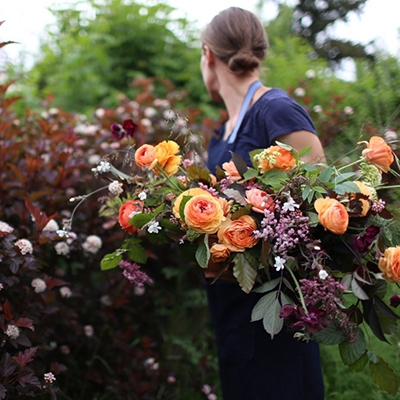
 When Erin Benzakein and her family started growing flowers commercially eight years ago at Floret Flower Farm in Washington State’s Skagit Valley, perennials were an important part of the mix. After weed pressure and voles wreaked havoc on the perennials, they switched to annuals only. “We were focusing on high volume and annuals,” Benzakein said recently.
When Erin Benzakein and her family started growing flowers commercially eight years ago at Floret Flower Farm in Washington State’s Skagit Valley, perennials were an important part of the mix. After weed pressure and voles wreaked havoc on the perennials, they switched to annuals only. “We were focusing on high volume and annuals,” Benzakein said recently. 
 Farmer to Farmer Profile
Farmer to Farmer Profile
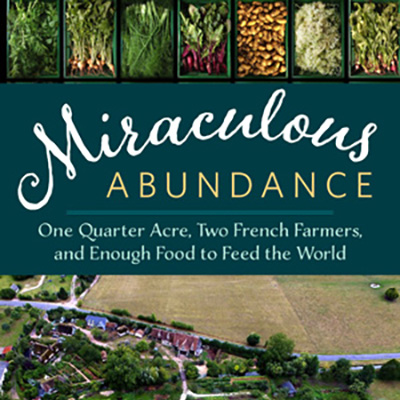
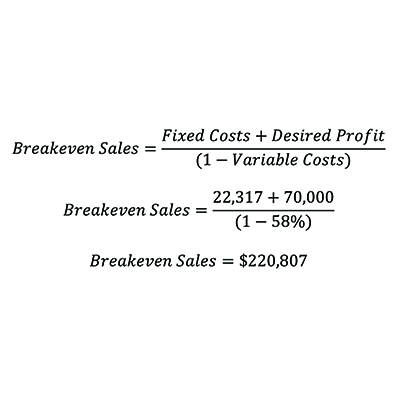
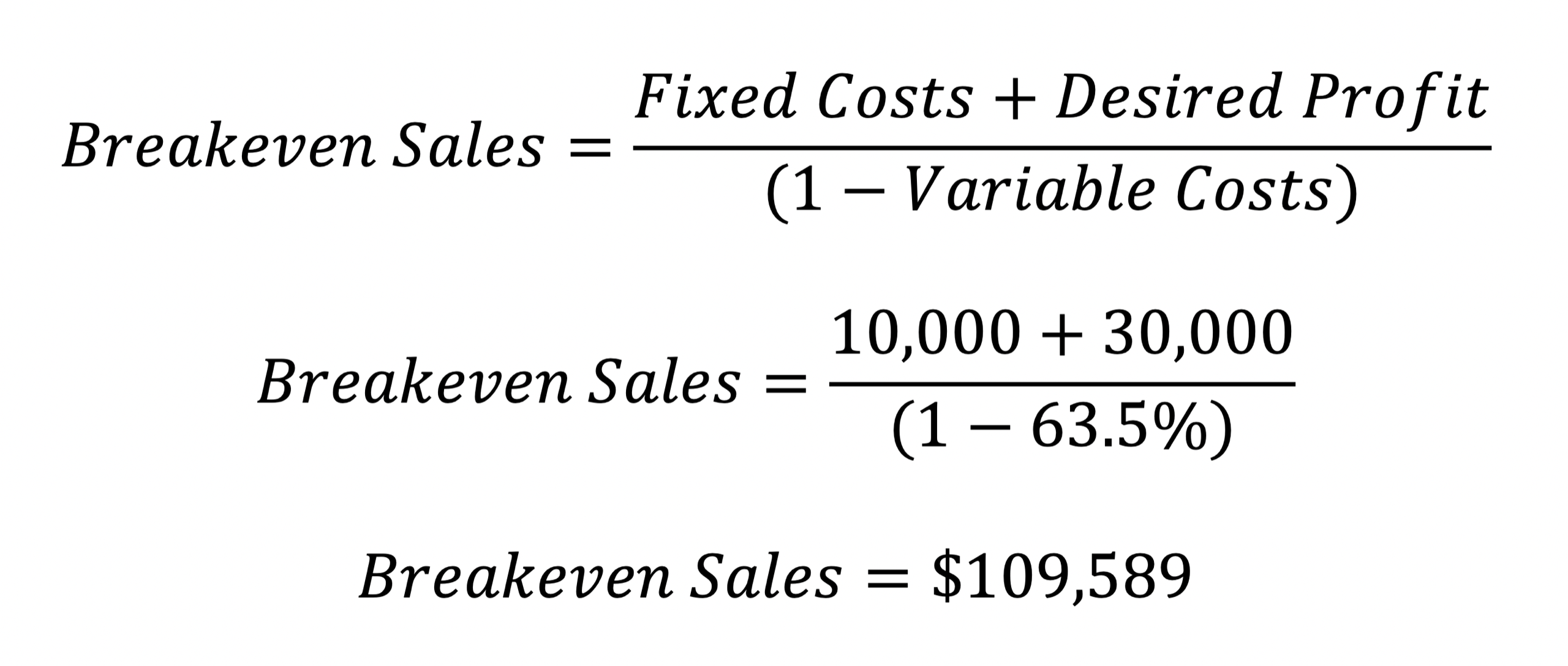 I’ve been teaching business skills and financial management to farmers for over ten years. When I started out, I was fresh out of business school and teaching college accounting. I was very academic in my approach.
I’ve been teaching business skills and financial management to farmers for over ten years. When I started out, I was fresh out of business school and teaching college accounting. I was very academic in my approach.
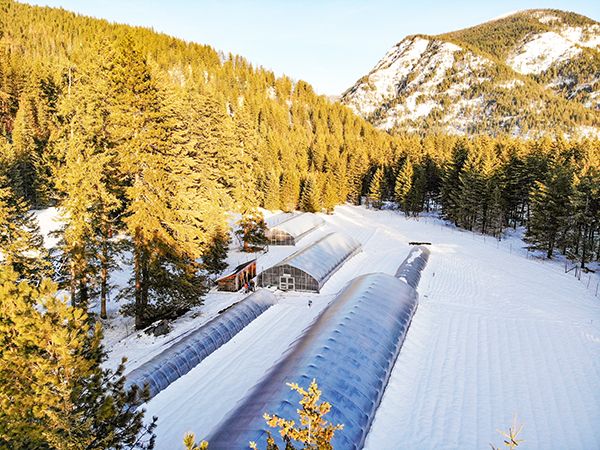 Like it or not, it is hard to exaggerate the importance of money in our farming lives. Most of us chose this profession for reasons unrelated to income, but money is the ultimate trump card when it comes to our farms’ viability. Put simply, if a farm spends more money than it earns for more than a short amount of time, no amount of planting plans, fertility regimens, or even tenacious hard work will keep it afloat.
Like it or not, it is hard to exaggerate the importance of money in our farming lives. Most of us chose this profession for reasons unrelated to income, but money is the ultimate trump card when it comes to our farms’ viability. Put simply, if a farm spends more money than it earns for more than a short amount of time, no amount of planting plans, fertility regimens, or even tenacious hard work will keep it afloat.
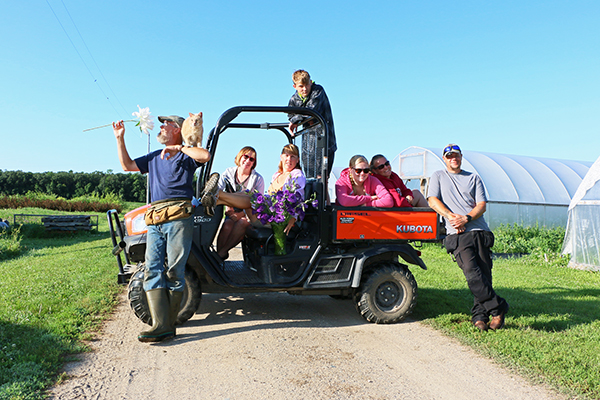 Here's a system to track all those details
Here's a system to track all those details
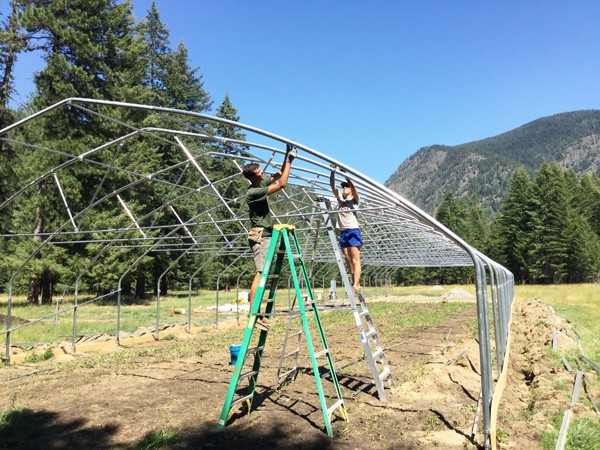 At the risk of taking the romance and wonder out of our profession, I think that farming can be boiled down to two important tasks: figuring out how to make money, and figuring out how to spend money. It might appear oversimplified, but when farmers decide which crops to grow, where to sell them, what techniques to use in growing them, how and when to harvest, and so on through the production cycle, we are just deciding how to make money and how to spend money; or, in a word, how to manage cash flow.
At the risk of taking the romance and wonder out of our profession, I think that farming can be boiled down to two important tasks: figuring out how to make money, and figuring out how to spend money. It might appear oversimplified, but when farmers decide which crops to grow, where to sell them, what techniques to use in growing them, how and when to harvest, and so on through the production cycle, we are just deciding how to make money and how to spend money; or, in a word, how to manage cash flow.